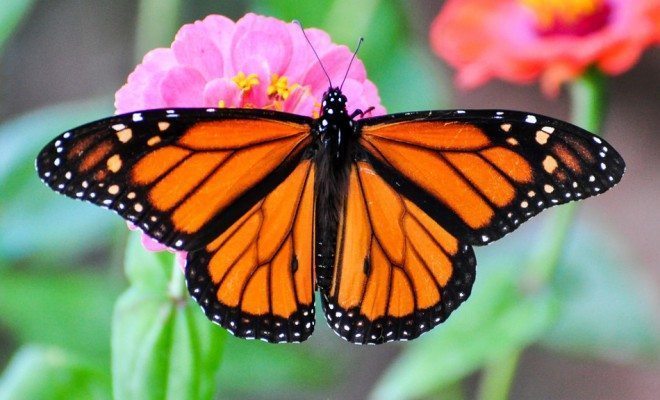 Image courtesy of [Peter Miller via Flickr]
Image courtesy of [Peter Miller via Flickr]
Energy and Environment
A Member of Royalty is in Trouble
Their tiny, delicate wings make their migration from Central Mexico to Southern Canada equitable to a trip from the Earth to the Moon and back. But due to climate change and habitat loss, the great Monarch Butterfly is growing endangered and few people are likely to act in their defense.
Butterflies are one of the first things we learn about in school, and one of the last that we come to appreciate. Many of us have fond elementary school memories of collecting caterpillars in jars for the classroom. It was an exciting project, but we rarely truly thought about the wonder of what was happening. During its time in the chrysalis, a caterpillar literally dissolves into a bag of liquid, to reassemble as a new creature. One that can take flight, and has an ingrained knowledge of its mission. A butterfly is a symbol of transformation; a reminder that patience and hard work can yield fantastic results.
Numbering in the half billions, Monarch Butterflies cluster in the Oyamel Fir Forests of Mexico, covering nearly ever square inch of tree trunk and branch. As spring appears and warms the air, they emerge from their sleepy lull and prepare for a fantastic journey. This group of insects can make it only so far, mating and subsequently dying somewhere in the Southern United States; however, their offspring appear shortly thereafter, and resume the flight northward. It takes three generations to make the trip, each one understanding its current location and distance it must travel. Then, one “super generation” makes the entire trip back to Mexico.

Courtesy of Agunther via Wikipedia.
The Oyamel Fir Forests are a product of older geological patterns, when the Earth was cooler and wetter. Monarch Butterflies are adapted to the same conditions; if it gets too hot or dry they are very susceptible to death. As the climate changes, the forest coverage recedes, leaving them vulnerable. In addition, the trees retain heat, which keeps the butterflies warm throughout the night and in general provides a suitable temperature zone for the delicate creatures. As illegal logging takes place in this region, poorly regulated by the Mexican government, the butterflies face threats on multiple fronts.
The brilliant orange shading of a Monarch’s wings is actually a defensive signal to predators, warning them of toxicity; few creatures are willing to eat a Monarch. This characteristic comes from a very particular diet, namely the milkweed leaf. It is on this plant that the caterpillar is born and, though a handful of flower types can provide food for the butterfly, is the only thing the caterpillar is capable of eating before making its transformation. Extensive use of certain herbicides and pesticides is killing milkweed in large swathes; caterpillars now face starvation before ever turning into butterflies.

A Monarch caterpillar. Courtesy of vladeb via Flickr.
In the last 20 years Monarch’s populations have declined by 90 percent, while they have lost over 160 million acres of habitat. So what is being done about this? This past August, scientists filed for protection of Monarch Butterflies under the Endangered Species Act. This would enable authorities to take more action with regard to the logging and pesticide use, as international regulations could help curb hazardous human activities.
In a recent meeting of the New Jersey chapter of the Sierra Club, panelists discussed the implementation of butterfly habitats on public property. This would basically be an extension of home gardening, insofar as planting milkweed nurseries outside on which butterflies can lay their eggs. We already enjoy hanging bird feeders in our yards and installing bird baths in parks, right? Birds are pleasant company. Butterflies are too; milkweed gardens in our yards, parks, and schools would draw beautiful creatures to our sides, enhancing our appreciation and outdoor experiences. Furthermore, as Conservation Chair of the Sierra Club’s Central Jersey Chapter Kip Cherry pointed out, it would bring greater visibility to the crisis.
Most recently, this endeavor has received a major boost from the Fish & Wildlife Service as well as the National Fish & Wildlife Foundation, who together will contribute over $3 million to assist in the development of butterfly oases in communities across the country. While some people are concerned that this action is not enough, as it does not address the use of pesticides that are killing milkweed plants in the first place, it is nonetheless a major effort to provide for the butterflies and may lead to further productive measures in the future.

A milkweed field. Courtesy of mwms1916 via Flickr.
The Butterfly Effect is a scientific model that suggests a minuscule action at the outset of an event can have titanic ramifications down the line. This is often metaphorically exemplified by images of the flapping of a butterfly’s wings setting in motion a chain of events that will alter the behavior of a hurricane. Similarly, this is a common literary tool, as when a time traveler in the past steps on a butterfly and in so doing induces drastic changes to the future. These constructions are poignant because they rely on our perceptions of a butterfly’s insignificance and lack of importance.
Some people might be hesitant to act in defense of butterflies. They conjure up images of effeminateness; a delicate creature is suitable for a delicate person, such as a Victorian gentleman traipsing about with a net. I myself have been laughed at after arguing that butterflies are awesome. In addition to this cultural stereotype, the bottom line is that butterflies are insects. They have antennae and lots of legs and people find these things gross. We flinch and shoo them if they get too close. We imagine insects in general as being infinitely numerous; it is hard to accept that some of them could disappear. As far as endangered species go, they are not comparable to the great Bengal tiger, or sweet and gentle manatee, or majestic humpback whale. In fact, though, they are all of these things. Our prejudices do not entitle us to judge which species deserve to survive or die off, especially if it is our actions that are putting them in that precarious position in the first place.

Courtesy of docentjoyce via Flickr.








Comments